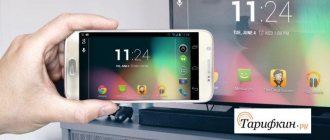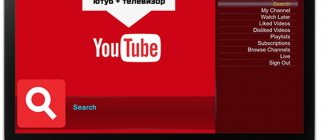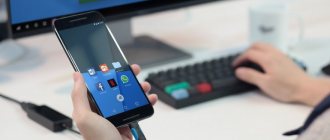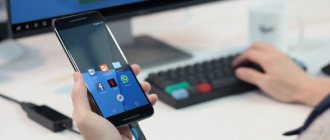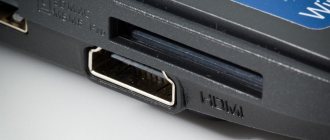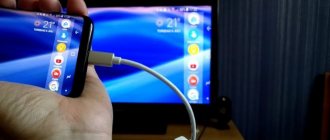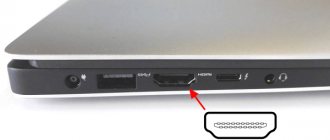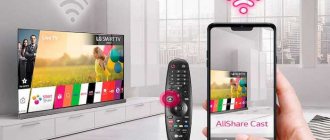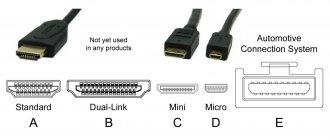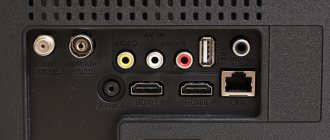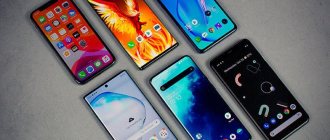What to do?
You are probably very familiar with the first three devices, but few people know what an MHL adapter is. Let's look at it in more detail.
In order to connect a smartphone and a TV via an HDMI cable, the TV must have an HDMI port, and the smartphone must have a microHDMI port, and you also need a corresponding cable. The problem is that only a small number of smartphones have a microHDMI port - manufacturers simply do not see the point in installing it, because it makes the device more expensive and takes up extra space in the case. This port on a smartphone is similar to a MicroUSB port, but they are similar only in appearance (for example, the BlackBerry Z10).
If your smartphone doesn't have a microHDMI port, you probably think it's impossible to connect it to your TV. This, fortunately, is not the case. Some time ago, Mobile High-Definition Link technology, or MHL for short, appeared. MHL is an interface standard that combines the functionality of HDMI and MicroUSB interfaces. In other words, with this wonderful technology you can connect your smartphone to your TV using HDMI technology using a special adapter. There is also an MHL cable. The difference is that the adapter operates from external power, while the cable does not require additional power.
The MHL adapter looks like this:
Its body also contains an additional microUSB port for receiving power. So, in order to connect a smartphone to a TV using HDMI technology, you need to connect an MHL adapter to the smartphone. Then a regular HDMI cable is connected to the adapter. The other side of the HDMI cable connects to the TV - on its back or side wall you can find a port or ports for connection.
Have you connected? Amazing. Now it all depends on the TV model. There are models where, when you connect a cable to the HDMI port, the picture from the device you just connected automatically turns on. If this does not happen, pick up the TV remote control, press the Source button and select the HDMI section.
After this, you will see the picture from your smartphone. Everything that is shown on its display, you will see on the TV screen. You can watch a movie or even play games. Very comfortably!
Just remember that in some cases it is worth completely disabling the screen off function on your smartphone or setting the maximum possible time, otherwise its display will turn off when idle.
As you can see, there is nothing complicated in connection, but you need to stock up on an MHL adapter in advance. Of course, only if your smartphone does not have a separate microHDMI port.
Wired connections
You can connect your smartphone to the TV using special cables using the following methods:
- Via USB;
- Via HDMI (directly or via MHL);
- SlimPort (uses both HDMI and another video connector).
Let's take a closer look at these options.
Method 1: USB
The simplest option, but the least functional. All you need is a USB cable, which usually comes with your phone.
- Connect your smartphone to the TV using a microUSB or Type-C cable, preferably the one included with your Android device.
- You must enable external media reading mode on your TV. As a rule, a window with the corresponding option appears when you connect an external device, in our case a smartphone.
You need to select “USB” or “Multimedia”. - By selecting the desired mode, you can view multimedia files from your device on the TV screen.
Nothing complicated, but the capabilities of this type of connection are limited to viewing photos or videos.
Method 2: HDMI, MHL, SlimPort
Now the main video connector for TVs and monitors is HDMI - more modern than VGA or RCA. An Android phone can connect to a TV using this connector in three ways:
- Direct HDMI connection: there are smartphones on the market that have a built-in miniHDMI connector (Sony and Motorola devices);
- According to the Mobile High-Definition Link protocol, abbreviated MHL, which uses microUSB or Type-C for connection;
- Via SlimPort using a special adapter.
To use a direct connection via HDMI, you must have an adapter cable from the mini version of this connector to the older version. As a rule, such cables come with the phone, but there are also third-party solutions. However, now devices with such a connector are almost never produced, so finding a cord can be problematic.
The situation is better with MHL, but in this case it is worth familiarizing yourself with the phone's specifications: budget models may not directly support this function. In this case, you should purchase a special MHL adapter for your phone. Additionally, technology standards vary by manufacturer. So, for example, a cable from Samsung will not fit to LG and vice versa.
For SlimPort, you also cannot do without an adapter, but it is only compatible with some smartphones. On the other hand, this type of connection allows you to connect your phone not only to HDMI, but also to DVI or VGA (depending on the adapter output connector).
For all connection options, the sequence of actions is the same, so regardless of the type of connector you use, follow these steps.
- Turn off your smartphone and TV. For HDMI and SlimPort - connect both devices with a cable and turn on. For MHL - first make sure that the ports on your TV support this standard.
- Enter your TV menu and select “HDMI” as the signal source.
If your TV has several such ports, you need to select the one to which the phone is connected. To connect via SlimPort via a connector other than HDMI, this happens automatically.When using MHL, be careful! If the port on the TV does not support this feature, you will not be able to establish a connection!
- If additional settings appear, set the values you need or leave them as default.
- Done - you will receive a high-resolution image from your phone, duplicated on your TV.
This method provides more options than a USB connection. The disadvantage of a direct HDMI connection is the need to use a phone charger. SlimPort is supported by a limited number of devices. MHL, on the other hand, has no obvious drawbacks, so it is one of the preferred options.
What is a high-definition multimedia interface on a TV?
The abbreviation "HDMI" is an abbreviation for "High Definition Multimedia Interface", which translates as "high-definition multimedia interface". This is a compact audio and video interface system that allows you to transfer data in digital format. Using an HDMI cable, you can send image, sound, video and other types of files from various sources (Blu-ray, audio box, DVD, game console, phone and others) to your TV.
An HDMI cable allows you to transfer picture and sound to another device. Currently, the format is implemented in the form of a high-bandwidth cable for high-speed data transfer.
HDMI greatly simplifies cable management by combining red, blue, green, yellow and white cables into one seamless analog cable. The high capacitance of such a cable allows you to send command codes along with image and sound.
HDMI cable and connector on laptop.
Connecting your phone to TV using micro (mini) HDMI
Not long ago, many Android phones included an HDMI port in their functionality. This is not a full-size connector, which can be found on TVs and laptops, but a mini or micro HDMI port.
Micro HDMI connector on a mobile phone. If you own such a smartphone, then all you need to do is buy the appropriate miniHDMI (microHDMI) cable. It can be purchased on Aliexpress or domestic online stores. It is enough to connect one plug of such a cable to your phone, the other to the TV. And then select the appropriate signal source on your TV.
Micro HDMI to HDMI cable
All you have to do is launch your favorite application (photo, video) and enjoy its display on the big screen. If the image is not displayed, or is displayed incorrectly, then in earlier models of TVs it is worth setting the appropriate image settings.
Set the appropriate video signal format.
Adapters and media players - broadcasting to a TV without Smart TV
Many people have relatively old TVs that have HDMI connectivity and have a flat screen, but do not support Smart TV.
You can buy a special Wi-Fi adapter for TV, but I would recommend choosing another option - a set-top box. There are a lot of models - from relatively cheap to quite expensive. If we are talking specifically about broadcasting from a phone to a TV, then the best option may be Google Chromecast - a media player controlled via a phone.
With its help, you can broadcast video from YouTube or other mobile applications, such as online cinemas, to the screen, and you can also broadcast an image from the screen of your phone.
You can buy a full-fledged set-top box with Android TV, for example, the inexpensive Mi Box from Xiaomi, but Google Chromecast is also suitable for broadcasting video or the smartphone screen to a TV.
You can find out more about settings and broadcasting from your phone to TV via Google Chromecast here.
Links to Xiaomi Mi Box S (I tested it after this publication, as a result, now I have two of these set-top boxes):
- https://aliclick.shop/r/c/1r1modenqdgtg6jw
- https://aliclick.shop/r/c/1r1moe4w324lzpc7>
It's also worth noting that I originally used Google Chromecast to stream video to a non-Smart TV. But now I also use it on a TV with a Smart TV, since the TV is a little slow and sometimes the Wi-Fi module “falls off”. And with the media player everything works very quickly and without failures.
Features of USB connection via full-size HDMI connector
In a much larger number of cases, your phone is equipped only with a micro-USB port, which we use as an output. Therefore, you will need to purchase a special microUSB - HDMI converter, which converts the signal from your phone into a signal type supported by your TV.
Converters are available in two versions:
| Mobile High-Definition Link (abbreviated as MHL) | They are an earlier standard, usually found in older TV models. |
| Slimport | A modern analogue, available in almost all modern TVs. |
Slimport adapters for converting signal to HDMI
As for Slimport adapters, this adapter looks similar to the MHL adapter. It connects to the micro USB port of your phone. And it allows you to display the image through the HDMI output of the TV. There are various variations of Slimport adapters. For example, the LG G Flex 2 adapter makes it possible to connect to a TV even if the latter does not have an HDMI port. There are also adapters that do not require independent power supply.
One of the "Slimport" adapters
You can find MHL and Slimport adapters in the price range from 1000 to 1500 rubles. The problem with both of these standards is their support, which varies widely between manufacturers. Make sure you research what wired options are available for your specific device before purchasing an adapter like this.
If it didn't work out
Devices may generate an error and disconnect. Most often, this problem occurs due to a loose cable inserted into the port. You must make sure that the wires are not damaged, otherwise you should buy a new cable.
If devices display synchronization, but do not execute commands, then you should update the phone firmware. Due to the lack of a driver, a crash may occur. There is a possibility of incompatibility between device models.
There may be malfunctions in the operation of gadgets, since the TV may not have built-in programs to recognize video and image formats. If the user has the ability to reformat materials, then this operation will be required. You can download special software through Google Market that converts files.
What to do if you need to connect your phone via USB-C to HDMI
If your gadget has a USB-C connector, then you can use a special cable or a USB-C to HDMI adapter to connect the TV to it.
This adapter connects to a phone with a USB-C connector, and its other end is connected to the TV using a standard HDMI cable. One end of it is connected to the USB-C connector of the smartphone, and the other to the HMDI connector on the TV. This will allow you to easily pair your devices. Very comfortably.
Connection via Miracast
With regular wireless synchronization, the TV and smartphone transmit the image via the home router, which can lead to some delays in the broadcast. You can get rid of them using a direct connection, but you can install it only when two devices support Miracast. The specification supports resolutions up to 1920x1080 pixels, that is, FullHD. Also worth noting is support for 5.1 surround sound.
Unlike the standard introduced by Apple (AirPlay), Miracast technology is completely open and can be used on any platform or device from various manufacturers.
You can use a Miracast connection even if the TV does not support this standard or does not have a wireless module at all. However, for this you will need to purchase a special external unit in the form of a small device the size of a USB drive. This accessory connects to the HDMI television port and makes it possible to connect it with a mobile device via a wireless network.
Wired methods
You can tell which wires, it’s the 21st century, bluetooth and wi-fi have existed for a long time, and in general the whole world is rapidly abandoning boring laces. I understand that it sounds like I want to bring back the "ancient ages", but that's not the case.
MHL adapter
An HDMI cable allows you to avoid delays in “picture jerking” when broadcasting the screen to a TV. And this can be relevant, for example, in games, dynamic films, and in work situations. Using an OTG or MHL adapter allows you to expand the standard capabilities of your smartphone: connect a keyboard, mouse, other peripherals, and charge the battery. In fact, you can use your mobile phone as a system unit, and the TV will act as a monitor.
In general, a wired connection has still not lost its relevance. But if for Android you can use an OTG or MHL adapter, then for iPhone you will have to buy a Lightning to HDTV Cable Video and Charge Plug And Play adapter with an HDMI connector. Now the prices for such accessories have dropped very much, so you don’t have to shell out 5,000 rubles for a plastic box.
SlimPort
Another cable connection option is through an obsolete SlimPort device. The principle of operation is similar to MHL, but there are versions for DVI, DisplayPort monitor and for the VGA input of the projector.
What's the best way?
If you can connect to HDMI, then there is no need to look for alternatives. These are both wide possibilities and high quality. Second place should be given to wireless connection methods for devices running the same OS or OS from the same manufacturer.
The option with Wi-Fi Direct is considered categorically inconvenient, although in some situations it is ideal. For example, if you need to view several files and the whole process takes a little time. The USB method, even if it fails, remains very accessible due to its prevalence, because almost every adapter has a USB connector. The MHL method has the most compatibility problems.
Quick way: use standard Wi-Fi and your Smart TV app on your phone, connecting through it to the TV screen
Owners of Android phones and Smart TV will enjoy Miracast. For a regular TV, buy an additional Chromecast.
Owners of Apple smartphones will benefit from a combination of the Apple TV 4K media player along with Lighting and Miracast adapters. In most cases, you will need different adapters to connect your phone to your TV. Buy these every chance you get.
By the way, Smart TVs can become part of a smart home. What it is and how to equip it, read this article.
In addition to smart TVs, there are other smart home devices designed to make your life more comfortable and simpler.
Wireless methods
There are completely free ways to display an image on a large TV screen from any phone. Let's figure it out.
Miracast
Miracast is a wireless analogue of an HDMI cable. To duplicate the display image, on an Android smartphone go to the “settings” - “connections” - “broadcast” menu, then press the “menu button” (top right, but the interface may differ), activate the function and wait 10-20 seconds. Basically, the technology is supported by all modern Smart TVs, both on Android and Tizen.
On some smartphones, “miracast” may be in the curtain and called differently, for example, “Wireless monitor”, “screen mirror”, “mirror shader”, “broadcast”; on Samsung this function is called “smartview”. In general, if you don’t find the menu in the Android settings, check the curtain.
If you have an iPhone, we recommend using AirPlay; essentially, if you don’t go into details, it’s the same thing. More details about this method below.
But Miracast has its own characteristics:
- When projecting an image onto a TV, you cannot lock your smartphone, otherwise the TV screen will go dark along with it,
- There is no multitasking, that is, you cannot broadcast a movie on TV and at the same time sit on VK or play a game. Friends and family will be aware of your correspondence, pop-up messages and other data.
Chromecast
An excellent option, but let’s make a reservation right away: in no case should you confuse the Chromecast technology and the Google Chromecast set-top box, these are completely different things. Google chromecast is simply the name of one of the many devices that support chromecast technology.
Chromecast technology supports a lot of different devices from Xiaomi, Samsung, Google to all sorts of Chinese no-names. The main difference from Miracast is that the image is not duplicated on a smartphone and TV. Technically, the mobile phone acts as a mega-convenient control panel (rewind, pause, forward, backward, etc.), since it simply “transmits the video link” to the TV without taking part in the streaming process. While watching the video, you can safely browse social networks without worrying that your correspondence will be “burned.”
To find out if your TV supports chromecast technology, connect your phone and TV to the same Wi-Fi network (one router, so that the IP addresses are from the same subnet). On a cell phone, in an application, for example, Youtube, this icon should appear.
You can use chromecast not only from a specific application, try calling Google Assistant on your phone and asking it to turn on the video on your TV. The assistant will find the desired video on the Internet and transmit it to the TV via Wi-Fi.
You may have noticed that the chromecast icon can be found not only on a smartphone, but also on a computer, in the Google Chrome browser. In the same way, find a movie on your laptop, then click on the chromecast icon (in the settings at the top right) and continue watching on your TV. Just like in the case of a telephone, after this you can turn off the laptop altogether and put it on the shelf. The PC is no longer involved in the process; the TV “pulls” the material directly from the site.
Other ways to connect your smartphone to your TV
In addition to connecting via HDMI wire, there are other ways to transfer images from your phone to the big screen.
- Via USB cable. This is the fastest and most affordable method, but is only suitable for cases when the phone is used as a flash drive, that is, only files located in the smartphone’s memory can be played - photos, videos, etc.
- Via Wi-Fi Direct. This connection is wireless, when the smartphone and TV are connected via Wi-Fi without the use of conductors and routers. The TV becomes the access point to which the phone connects. It will be possible to send a picture to its screen using the “send” button from the standard menu.
- Via DLNA. This is already a connection that uses a router. The TV can be connected using a cable, and the phone can be connected via Wi-Fi. When connecting via DLNA, you can display all files stored in the phone's memory on the big screen.
- Via AitPlay. This option is suitable for phones with the iOS operating system. This is the easiest and most convenient way to connect iPhones to a TV with an Apple set-top box. Content streams to Apple TV in seconds, so you can view presentations, play games, watch movies, and more.
- Via Miracast. This method will work for all TVs that support Miracast. This technology works on the principle of AirPlay, but is intended for androids. The advantage is that with the help of a special adapter it can be connected to any TV that supports HDMI. If a particular user has a Smart TV installed, then the connection will be made right out of the box, so an adapter will not be required.
- Via Chromecast. This is a technology for mirroring your phone screen onto a TV from Google Chrome. To use it, you need to purchase a branded set-top box, and the TV must support an HDMI connection. There are two versions - one is normal, the other has improved display quality. Using Chromecast, you can also view files from your phone's internal storage, show presentations, view gallery photos, and run various applications and games.
In general, connections via USB, DLNA and Wi-Fi Direct are already outdated and not popular, but they are suitable as backup options in case of connection problems. Today, wireless connections via HDMI are also relevant. Which method to choose will depend on the brand of phone and model of TV. For example, for Android phones and a Smart TV, the best option would be to connect via Miracast.
0 0 Votes
Article rating
Instructions for connecting Android smartphones
By connecting your phone, you can view photos, watch videos or play games - all of which will be displayed on the TV screen. There are many options for managing content through your TV. It all depends on the phone model and operating system. In this case, let's look at how to connect an Android phone to a TV using an HDMI cable.
To connect you will need a TV and smartphone, an HDMI cable or an MHL adapter. Some time ago, major phone manufacturers equipped their devices with a mini HDMI port. Over time, well-known brands began to abandon this idea. The presence of a port significantly increased the cost of gadgets. Therefore, all modern mobile devices now have a USB connector.
If your smartphone does have a port for an HDMI cable, you need to follow several steps to connect.
- On your TV you need to go to settings. In the signal source menu, select the desired item – HDMI.
- Then the mobile gadget is connected using an HDMI cable.
- Next, automatic image viewing should begin. If this does not happen, you need to open the phone settings and specify the required resolution frequency.
When connecting your phone via HDMI, you need to take into account that the device will not charge. When using the gadget for a long time with a TV, you should connect the charger.
Connecting iPhone via HDMI adapter
It is a well-known fact that Apple phones have always differed in their approach to communicating between the phone and other devices via cable. The fact is that the iPhone is equipped with its own Lighting type connector . An MHL cable or adapter will not work for it. But there is a way out.
You can connect your iPhone to a TV or other device with an HDMI port using the Apple Lightning 8-pin MFI to HDMI adapter. It should be noted that in this case you only buy the adapter itself. The cable for connecting a smartphone via HDMI must be purchased separately.
The connection itself via the adapter is no different from connecting other devices. On the TV you need to select the desired HDMI port and a picture of the iPhone desktop will appear on the screen.
Original Apple accessories are often very expensive. You can look for similar cheap adapters on Chinese Internet sites and marketplaces.
How to connect your phone to TV via HDMI
Most modern TVs have an HDMI High – Definition Multimedia Interface port. The technology replaces analog connection standards and allows you to fully display a smartphone display of any diagonal on the TV screen. In this case, the quality of videos and photos is lost; you can watch movies from YouTube or view pictures taken at the camera’s maximum resolution.
To connect your phone to a TV from LG, Sony, Philips and other brands, you need to buy a USB to HDMI adapter. Some TV models have a built-in micro-HDMI or mini-HDMI port, which greatly simplifies connection and eliminates the need to purchase a special adapter.
What to do:
- Turn off your phone and TV, connect the HDMI cable to them and turn them on again.
- Some TV models, after turning on, automatically find the smartphone and identify it as a flash drive. If this does not happen, carry out the actions in this sequence.
- Go to the TV menu and select HDMI as the signal source.
Adjust the image resolution and frequency. Experts recommend using MHL or SlimPort adapters to connect your smartphone to your TV. The devices charge your phone when paired and significantly improve signal quality and data transfer speeds.
Broadcast Miracast to Smart TV or Miracast adapter.
Many more or less modern TVs have Miracast support, and if it doesn’t, you can buy a Miracast adapter, which is not that expensive.
Thanks to Miracast, you can broadcast the screen of your smartphone to your TV - it can be a mobile game, a movie running anywhere, or just the Android desktop - everything is displayed the same as on the phone.
To do this, you need to enable Miracast on your TV: “Settings” -> Network -> Miracast / Intel's WiDi -> Enable Miracast. On different TV models, the path to enable Miracast or the names of items in the menu may differ.
You need to turn on the broadcast on the smartphone itself. It can be found on some smartphone models in the notification shade or in the phone settings. Go to Settings and search for “Broadcast” or “Wireless Display.” You need to select your TV from the list of supported devices.
The broadcast occurs with a delay of about one second. Since the sound is transmitted to the TV along with the video, there will be no desynchronization of the picture and sound on the TV itself, so you can watch video clips without discomfort. But you can only play mobile games in public. Due to the delay, the controls in the game become extremely inconvenient, so the player can look at the smartphone screen, and everyone else can look at the TV screen; the delay does not bother them.
How to connect your phone to TV via Wi-Fi
Wi-Fi wireless data transmission technology is named from the English phrase Wireless Fidelity - wireless precision. A simple and free method allows you to connect your TV to a phone running older versions of Android – 5.0 and lower, without any additional devices – and transfer information at speeds of up to 6 Gbps. The devices are paired via Wi-Fi Direct technology, which is built into the menu. The main condition is fast Internet; when connecting to a service package from a provider, choose a speed of 50 Mbit/s.
What to do:
Charge your phone, as wireless data transfer takes up a lot of battery power, or connect a power bank to your smartphone. Disable other apps that are draining your battery.
- Switch the television to “Network” mode using a special button on the remote control.
- In your phone settings, find a list of wireless data transfer methods and select “Wi-Fi.”
- Click on the icon and activate the home network to which your phone and TV are connected.
- In the settings menu, click on “Additional features” and go to the “Wi-Fi Direct” line.
- From the TV remote control, enter the “Network” menu.
- On the screen, open the list of available devices and find the name of the smartphone.
- Select a phone and activate the connection request with the OK button.
Confirm the signal from your smartphone and establish pairing. If your home network is not password-protected, set a password on your router so that strangers cannot connect to your Internet. It is more convenient to connect your phone to your LG TV by launching the built-in Smart Share program. A similar AllShare function on Samsung TVs quickly starts pairing with a smartphone.
Problem situations
The main problem when connecting is outdated television equipment. It has only a few connectors, and connection requires the purchase of additional adapters and modules. The most inexpensive connection is the USB cable included with the phone. But limited functionality depreciates the method. And set-top boxes from Apple or Google are expensive.
In this case, you should think about purchasing a new TV. For example, models with Smart TV allow you to view video content directly on the Internet.
A wireless connection in the absence of Wi-Fi Direct and DLAN requires the purchase of auxiliary devices. Therefore, HDMI pairing for phone and TV remains the most reasonable and cost-effective. If you use Miracast technology, the socket for connecting the charger will remain free.
How to connect your phone to TV via USB
A USB - Universal Serial Bus port is found on the back or side of most LCD or plasma TVs. If the model does not support wireless data transfer technologies, you can connect your smartphone to your old TV via a cord. For convenience, we recommend purchasing a universal adapter with different ports: USB Type-C on one end, HDMI, VGA, DVI, Display Port or miniDP on the other.
What to do:
To connect your phone to your TV via USB, take a cord from the charger or buy a simple cable with an adapter.
- Connect the adapter to your TV and smartphone. If connected correctly, a charging signal should appear on the phone screen.
- Set your TV to external file reading mode so that it recognizes your phone as an external drive or flash drive.
- On the remote control, press the Source, Multimedia, USB, Home button (depending on the model).
- In the list on the screen, find the name of the phone as a source of media files and indicate their type - photo, music or video.
- On Android phones 6.0 and higher, you need to select the line “Transfer files” or “Transfer photos” from the list on the phone screen. Folders with files from the smartphone’s memory or SD card will appear on the TV screen.
We use Wi-Fi Direct
The advantage of this technology is that setting up a home Wi-Fi network and registering both devices in it is not required - the gadget connects to the TV via Wi-Fi directly. The important thing is that both devices must support this feature. “Connect” happens like this:
- Wi-Fi Direct runs on the gadget. The user needs to follow the path “Settings” “Wireless networks and connections” “Wi-Fi Direct”. You should click “Activate” or “Ok” (depending on the model).
- The function starts on TV. You need to go to the menu, select “Network” and find Wi-Fi Direct in the list of options. After activating the function, a list of devices available for connection appears - from the list you should select the smartphone that was configured earlier.
- The smartphone receives a request to confirm the connection. Just click “Yes” and use Wi-Fi Direct for your pleasure.
DLNA connection
Nowadays, wireless connections look much more attractive. If your mobile and TV are connected to the same local network, then you can use DLNA technology to connect them. Modern TVs usually do not require additional devices and have built-in DLNA functionality. For older models that are not intended for a network environment, the DLNA center can be a media player, game console, or a special Android set-top box (for example, Chromecast). All DLNA certified devices have a DLNA certified logo or sticker indicating that the product has been tested for compliance and is capable of connecting to other certified devices.
In order to create your own DLNA server for broadcasting movies and music, you need to install a special program on your phone. After that, launch the server, connect it via Wi-Fi to your home network and enjoy watching.
Possible problems
There are cases when the phone does not connect to the TV. The TV does not see the smartphone for various reasons. Possible problems are worth considering in more detail.
The first thing you should pay attention to when connecting is the type of connection on the phone itself. On smartphones based on Android OS, you need to swipe down to open the curtain at the top of the screen and change the connection type. If, when you connect your smartphone, the TV still does not show the connection type, you need to take the following steps:
- connect your smartphone to your computer;
- change the connection type again;
- connect your phone to the TV again.
When changing the connection, you need to take into account that if the TV does not see the smartphone when used in MTP (Media Transfer Protocol) mode, then you need to select the PTP mode or a USB device.
If the problem is not connecting the phone, and the TV still does not display the picture on the screen, you need to make sure that the TV model supports one or another image/video/game format. As a rule, the supported file type is indicated in the operating instructions. Using a converter, you need to convert files on your phone to the required, supported format for your TV.
Another connection problem is the lack of TV support for some applications from the Play Market. In this case, the TV simply will not respond to the request to connect a mobile device.
The TV may not see the mobile device due to the connection via the HDMI-RCA cable. The wire looks like an HDMI plug on one end and with “tulip tails” on the other. This type of cable is used in older models. Connecting a phone through such a cable makes no sense. The received signal will not be converted to digital, so connecting the phone will not produce any results. In times of more advanced TV models, connection through such a wire is impossible. But this problem occurs in the case of non-new models.
If the connection is successful, but there is no picture, the problem may be with the smartphone. Older device models have poor image quality and slow transfer speeds. Therefore, when displayed on a TV screen, the picture will slow down or be completely absent. This should also be taken into account when running games on a big screen. As a rule, games have a specific value for the speed of updating video footage or updating frames. Playing games through your phone on your TV screen is not worth the wait.
The most common cause of possible connection problems may be the condition of the HDMI cable or ports. You need to check the integrity of the wire and the condition of the ports.
If there are breaks, cracks or other damage, the cord should be replaced. You also need to check the status of the ports on the back of the TV. If there is visible external damage, contact a service center. It is impossible to fix the problem on your own.
The world of modern technology does not stand still. The new ability to view files from your phone on the TV screen has pleased many users. It's very convenient and interesting. On the big screen you can watch videos, view photos, play, learn something new through smartphone applications. Connection between devices is possible using many methods. In this particular case, the HDMI cable functions as an excellent conductor from the phone to the display device.
Before connecting via HDMI cable, you must study the characteristics of the paired devices. This article will help you understand the connection setup and help troubleshoot some problems between devices.
Which TV can I connect to?
The year of manufacture of the TV matters for synchronization, since modern models from 2011 have new connectors and built-in functions. Image quality and the presence of many commands in the interface are also important when connecting a phone. To connect, the user needs to consider several factors:
- You will need to inspect the TV ports to find the right cable to connect to your phone. It is necessary to pay attention to the connectors if the user plans to synchronize via wire. As a rule, most models are equipped with HDMI and USB ports;
- You can connect devices in a non-standard way using wireless networks, if your TV supports this option. Then you need to make sure that the gadget’s characteristics include working Wi-fi or Bluetooth.
The most accessible way is through the HDMI interface. Every modern TV and most older models support it. Even if your mobile does not have an HDMI connector, it is much easier to purchase an adapter or adapter. It has a small price, but you will get access to all the functionality, you will be able to play any media files, connect other devices (mouse, keyboard, gamepad), and access the Internet.
5/5 — (1 vote)
